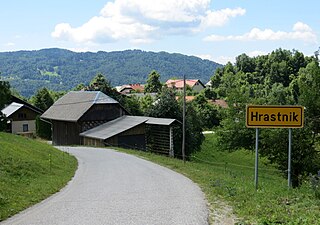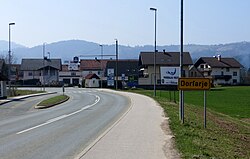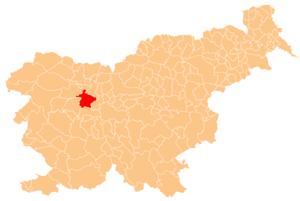
The Battle of Dražgoše was a Second World War battle between the Slovene Partisans and Nazi Germany armed forces, which took place between January 9 and January 11, 1942, in the village of Dražgoše. This battle was the first direct confrontation between the two. It ended with brutal reprisals of German forces against the villagers and the destruction of the village.

Travni Dol is a small settlement in the hills south of Novo Mesto in southeastern Slovenia. The area is part of the traditional region of Lower Carniola and is now included in the Southeast Slovenia Statistical Region.

Progër is a village and a former municipality in the Korçë County, southeastern Albania. At the 2015 local government reform it became a subdivision of the municipality Devoll. The population at the 2011 census was 3,988. The municipal unit consists of the villages Progër, Mançurisht, Cangonj, Pilur, Vranisht, Bickë, Rakickë and Shyec.

Dolenja Žetina is a dispersed settlement below Mount Blegoš in the Municipality of Gorenja Vas–Poljane in the Upper Carniola region of Slovenia. It is a clustered village on a low terrace in the foothills of Mount Koprivnik. There are many springs in the area and there are abandoned mills in the two ravines below the settlement.

Križevska Vas is a small settlement in the Municipality of Dol pri Ljubljani in the eastern Upper Carniola region of Slovenia.

Štrukljeva Vas is a small village east of Begunje in the Municipality of Cerknica in the Inner Carniola region of Slovenia.

Bukovje is a settlement in the hills north of Bizeljsko in the Municipality of Brežice in eastern Slovenia. The area was traditionally part of Styria. It is now included with the rest of the municipality in the Lower Sava Statistical Region. It includes the hamlets of Graben to the west, which partially lies in the valley of Sračjak Creek, and Žalce, just above the Sotla River.

Planina v Podbočju is a remote small village in the Gorjanci Hills in the Municipality of Krško in eastern Slovenia, right on the border with Croatia. The area was traditionally part of Lower Carniola. It is now included in the Lower Sava Statistical Region.

Dolga Vas is a settlement on the Rinža River southeast of the town of Kočevje in southern Slovenia. The area is part of the traditional region of Lower Carniola and is now included in the Southeast Slovenia Statistical Region.

Klinja Vas is a village north of Kočevje in southern Slovenia. The area is part of the traditional region of Lower Carniola and is now included in the Southeast Slovenia Statistical Region.

Nemška Loka is a settlement in the Municipality of Kočevje in southern Slovenia. It was inhabited mostly by Gottschee Germans. During the Second World War its original population was expelled. The area is part of the traditional region of Lower Carniola and is now included in the Southeast Slovenia Statistical Region.

Stari Kot is a village in the Municipality of Loški Potok in southern Slovenia, next to the border with Croatia. The area is part of the traditional region of Lower Carniola and is now included in the Southeast Slovenia Statistical Region. It consists of the hamlets of Binkl, Kurja Vas, Pri Ambrožiču, Hrib, and Preska. The main road from Lazec to Prezid runs through the village.

Rupe is a small remote settlement in the hills south of Rob in the Municipality of Velike Lašče in central Slovenia. The entire municipality is part of the traditional region of Lower Carniola and is now included in the Central Slovenia Statistical Region.

Janče is a dispersed settlement in the hills south of the Sava River east of the capital Ljubljana in central Slovenia. It belongs to the City Municipality of Ljubljana. It was part of the traditional region of Lower Carniola and is now included with the rest of the municipality in the Central Slovenia Statistical Region.

Šentpavel is a settlement in the hills southeast of the capital Ljubljana in central Slovenia. It belongs to the City Municipality of Ljubljana. It was part of the traditional region of Lower Carniola and is now included with the rest of the municipality in the Central Slovenia Statistical Region.

Hrastnik is a settlement in the hills to the northeast of Moravče in central Slovenia. Traditionally the area was part of Upper Carniola. It is now included with the rest of the Municipality of Moravče in the Central Slovenia Statistical Region. The settlement includes the hamlets of Kal, Hruševje, and Grad.

Žvirče is a village in the Municipality of Žužemberk in southeastern Slovenia. The area is part of the historical region of Lower Carniola and is now included in the Southeast Slovenia Statistical Region.

Seč is a remote abandoned settlement in the Municipality of Novo Mesto in southern Slovenia. The area is part of the traditional region of Lower Carniola and is now included in the Southeast Slovenia Statistical Region. Its territory is now part of the village of Travni Dol.

Šenberk is a remote abandoned former settlement in the Municipality of Kočevje in southern Slovenia. The area is part of the traditional region of Lower Carniola and is now included in the Southeast Slovenia Statistical Region. Its territory is now part of the village of Stari Log.

Kuželič is a small uninhabited settlement west of Vas in the Municipality of Kostel in southern Slovenia. The area is part of the traditional region of Lower Carniola and is now included in the Southeast Slovenia Statistical Region.
















